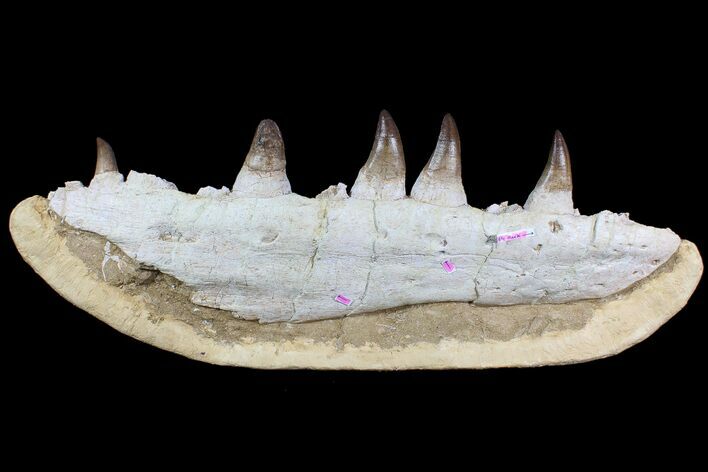This Specimen has been sold.
Massive, 25" Mosasaur (Prognathodon) Jaw - With Huge Bite Mark!
This is a HUGE jaw section of a very large Mosasaur (Prognathodon) from the phosphate deposits of Morocco. The awe inspiring fossil measures 25" in length and the largest teeth have crowns over 2 1/2" long. It's nicely prepared in the US with NO COMPOSITING and very little repair and restoration (part of one tooth).
There are a few features that make this a very special fossil other than being a massive Mosasaur jaw. One, four unerupted teeth are still present and and viewable in their sockets on the back side of the piece. Secondly, there is a big BITE MARK viewable on the from side of the jaw. The teeth marks in the bite mark are over 4" apart, meaning the Mosasaur that attacked this one was a real monster!
The rock has been stabilized with plaster (yellow areas around edges of piece, and it comes with a display stand.
There are a few features that make this a very special fossil other than being a massive Mosasaur jaw. One, four unerupted teeth are still present and and viewable in their sockets on the back side of the piece. Secondly, there is a big BITE MARK viewable on the from side of the jaw. The teeth marks in the bite mark are over 4" apart, meaning the Mosasaur that attacked this one was a real monster!
The rock has been stabilized with plaster (yellow areas around edges of piece, and it comes with a display stand.
Mosasaurs were a family of enormous marine reptiles that truly dominated the seas 90 million years ago, ruling during the last 20-25 million years of the Cretaceous period. With the extinction of the ichthyosaurs and decline of plesiosaurs, mosasaurs diversified to become prolific apex predators in nearly every habitat of the oceanic world.
Larger mosasaurs were the great leviathans of their time, extending 10–15 meters, or 33–49 feet long. Hainosaurus holds the record for the longest mosasaur at a seemingly impossible 57 feet. The smaller genera were still an impressive 10–20 feet long.
Mosasaurs probably evolved from semi-aquatic scaled reptiles, perhaps more similar in appearance to modern-day monitor lizards. They had double-hinged jaws and flexible skulls much like that of a snake which enabled them to gulp down their prey almost whole.
The gruesome unchewed contents of fossilized mosasaur guts have revealed a varied diet of sea birds, ammonites, smaller marine lizards, possibly sharks, and even other mosasaurs. Ammonites were especially crunchy mosasaur treats. They were abundant in the Cretaceous seas, and some mosasaurs had specialized teeth for the job.
Mosasaurs probably lurked for an ambush, rather than hunt, using their powerful tail flukes for extra thrust to dart out and swallow unsuspecting prey. Non-reflective, keeled scales may have been a great advantage to the mosasaur sneak-attack.
Mosasaurs breathed air and gave birth to live young. The bronchi leading to the lungs run parallel to each other, instead of splitting apart from one another as in monitors and other terrestrial reptiles. They were well-adapted to living in the warm, shallow, epicontinental seas of the period.
Although mosasaurs diversified and proliferated at a spectacular rate, their specialization is considered the source of their demise when marine systems collapsed at the end of the Cretaceous.
Larger mosasaurs were the great leviathans of their time, extending 10–15 meters, or 33–49 feet long. Hainosaurus holds the record for the longest mosasaur at a seemingly impossible 57 feet. The smaller genera were still an impressive 10–20 feet long.
Mosasaurs probably evolved from semi-aquatic scaled reptiles, perhaps more similar in appearance to modern-day monitor lizards. They had double-hinged jaws and flexible skulls much like that of a snake which enabled them to gulp down their prey almost whole.
The gruesome unchewed contents of fossilized mosasaur guts have revealed a varied diet of sea birds, ammonites, smaller marine lizards, possibly sharks, and even other mosasaurs. Ammonites were especially crunchy mosasaur treats. They were abundant in the Cretaceous seas, and some mosasaurs had specialized teeth for the job.
Mosasaurs probably lurked for an ambush, rather than hunt, using their powerful tail flukes for extra thrust to dart out and swallow unsuspecting prey. Non-reflective, keeled scales may have been a great advantage to the mosasaur sneak-attack.
Mosasaurs breathed air and gave birth to live young. The bronchi leading to the lungs run parallel to each other, instead of splitting apart from one another as in monitors and other terrestrial reptiles. They were well-adapted to living in the warm, shallow, epicontinental seas of the period.
Although mosasaurs diversified and proliferated at a spectacular rate, their specialization is considered the source of their demise when marine systems collapsed at the end of the Cretaceous.
SPECIES
Prognathodon sp.
LOCATION
Oulad Abdoun Basin, Morocco
FORMATION
Phosphate Deposits
SIZE
Jaw 25" long, Entire piece, 28" long
CATEGORY
SUB CATEGORY
ITEM
#77913
We guarantee the authenticity of all of our specimens.
 Reviews
Reviews




















